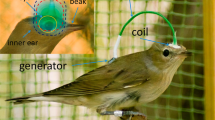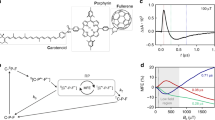Abstract
The compass sense of birds is based on both celestial (Sun, sunset, skylight polarization pattern, stars) and geomagnetic cues1–3. Songbirds, from birth prevented from seeing celestial cues, orient by a magnetic compass4,5, and so do young homing pigeons before the development of their Sun compass6,7. Furthermore, young homing pigeons exposed to aberrant solar conditions, acquire a correspondingly erroneous8 or incomplete9 Sun compass. These findings suggest that the magnetic sense may provide a primary and innate reference frame for the calibration/learning of the birds' celestial compass system8,9. We have investigated the role of the geomagnetic field in the development of birds' compass sense, by shifting the geomagnetic field at pied flycatchers' (Ficedula hypoleuca) nests during the incubation and nestling periods. The magnetic field was shifted by Helmholtz coils mounted at the nest-boxes. A corresponding shift in the migratory orientation was observed 2 months later in the young birds' lives. This supports the magnetic calibration hypothesis, indicating imprinting-like learning at an early age of celestial compass cues used in migratory orientation.
This is a preview of subscription content, access via your institution
Access options
Subscribe to this journal
Receive 51 print issues and online access
$199.00 per year
only $3.90 per issue
Buy this article
- Purchase on Springer Link
- Instant access to full article PDF
Prices may be subject to local taxes which are calculated during checkout
Similar content being viewed by others
References
Emlen, S. T. Avian Biol. 5, 129–219 (eds Farner, D. S. & King, J. R.) (Academic, New York, 1975).
Wiltschko, W. & Wiltschko, R. J. Orn. 117, 362–387 (1976).
Keeton, W. T. in Proc. 17th Int. Ornithological Congr., 137–157 (ed. Nöhring, R.) (Deutschen Ornithologen-Gesellschaft, Berlin, 1980).
Wiltschko, W. & Gwinner, E. Naturwissenschaffen 61, 406 (1974).
Beck, W. & Wiltschko, W. Z. Tierpsychol. 60, 41–46 (1982).
Keeton, W. T. Proc. natn. Acad. Sci. U.S.A. 68, 102–106 (1971).
Wiltschko, R. J. Orn. 121, 121–143 (1980); 122, 1–22 (1981).
Wiltschko, W., Wiltschko, R. & Keeton, W. T. Behav. Ecol. Sociobiol. 1, 229–243 (1976).
Wiltschko, R., Nohr, D. & Wiltschko, W. Science 214, 343–345 (1981).
Bibby, C. J. & Green, R. E. J. Anim. Ecol. 49, 507–521 (1980).
Gwinner, E. A. Rev. Ecol. Syst. 8, 381–405 (1977).
Gwinner, E. & Schwabl-Benzinger, I. in Avian Navigation, 75–89 (eds Papi, R. & Walraff, H. G.) (Springer, Berlin, 1982).
Batschelet, E. Statistical Methods for the Analysis of Problems in Animal Orientation and Certain Biological Rhythms (American Institute of Biological Sciences, Washington DC, 1965).
Wiltschko, W., Wiltschko, R., Keeton, W. T. & Madden, R. Behav. Ecol. Sociobiol. 12, 135–142 (1983).
Wiltschko, W. & Wiltschko, R. Z. Tierpsychol. 37, 337–355, 39, 265–282 (1975).
Wiltschko, W. & Wiltschko, R. J. comp. Physiol. 109, 91–99 (1976).
Keeton, W. T. Science 165, 922–928 (1969).
Able, K. P. in Animal Migration, Orientation and Navigation, 283–373 (ed. Gauthreaux, S. A.) (Academic, New York, 1980).
Wiltschko, W., Gwinner, E. & Wiltschko, R. Z. Tierpsychol. 53, 1–8 (1980).
Gould, J. L. Nature 296, 205–211 (1982).
Author information
Authors and Affiliations
Rights and permissions
About this article
Cite this article
Alerstam, T., Högstedt, G. The role of the geomagnetic field in the development of birds' compass sense. Nature 306, 463–465 (1983). https://doi.org/10.1038/306463a0
Received:
Accepted:
Issue Date:
DOI: https://doi.org/10.1038/306463a0
This article is cited by
-
Geomagnetic disturbance associated with increased vagrancy in migratory landbirds
Scientific Reports (2023)
-
The Yellow-browed Warbler (Phylloscopus inornatus) as a model to understand vagrancy and its potential for the evolution of new migration routes
Movement Ecology (2022)
-
Re-calibration of the magnetic compass in hand-raised European robins (Erithacus rubecula)
Scientific Reports (2015)
-
Star compass learning: how long does it take?
Journal of Ornithology (2014)
-
Orientation of the pied flycatcher Ficedula hypoleuca: cue-conflict experiments during spring migration
Behavioral Ecology and Sociobiology (2010)
Comments
By submitting a comment you agree to abide by our Terms and Community Guidelines. If you find something abusive or that does not comply with our terms or guidelines please flag it as inappropriate.



